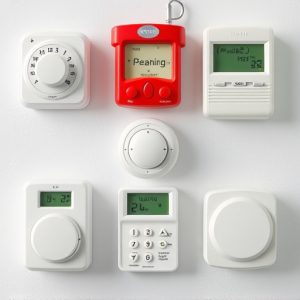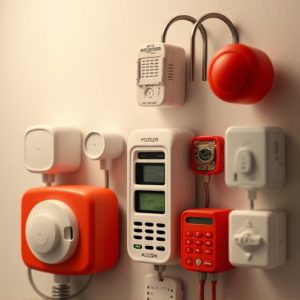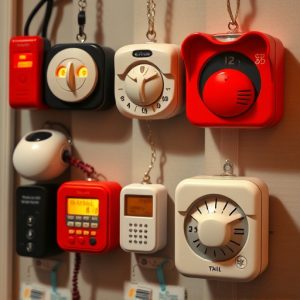Maximizing Personal Safety: Powerful Alarms & Location Sharing
Personal Safety Beacons, integrating GPS technology, offer modern solutions in emergencies. With a p…….
Personal Safety Beacons, integrating GPS technology, offer modern solutions in emergencies. With a push of a button, these devices emit powerful alarms (up to 120 dB) with coordinates, alerting emergency services and loved ones. Ideal for outdoor enthusiasts, travelers, and remote dwellers, they ensure distinct audibility even in noisy environments. While location sharing enhances security, privacy concerns require robust encryption. Balancing safety and privacy is crucial for public acceptance of these life-saving technologies, which should be regularly tested and calibrated for optimal effectiveness. Pairing with mobile apps offers real-time tracking for quicker response times.
In today’s world, personal safety is paramount. This is where personal safety beacons with location sharing step in as innovative solutions, especially in emergency situations. This article delves into the effectiveness of these devices, exploring key aspects like understanding their functionality, the benefits and privacy considerations of location sharing, and optimal maximum decibel personal alarm safety.
We’ll guide you through implementing best practices for users, ensuring you’re prepared and protected.
- Understanding Personal Safety Beacons: A Modern Solution for Emergency Situations
- The Role of Location Sharing in Enhancing Safety: Benefits and Privacy Considerations
- Decibel Power: How Loud Should a Personal Alarm Be?
- Implementing Maximum Decibel Personal Alarm Safety: Tips for Users and Best Practices
Understanding Personal Safety Beacons: A Modern Solution for Emergency Situations
Personal Safety Beacons, often integrated with location-sharing technology, offer a modern solution to emergency situations. These devices are designed to ensure individuals’ safety by emitting powerful alerts that can be heard up to 100 meters away, providing crucial time for help to arrive. They are especially useful in scenarios where someone might be alone or in an area without immediate access to communication methods.
With the push of a button, these beacons can send out a signal containing the user’s GPS coordinates, alerting emergency services and loved ones of their location. This feature is particularly beneficial for outdoor enthusiasts, travelers, and individuals living or working in remote areas where quick response times are vital. The maximum decibel level ensures that the alarm is distinct and audible, even in noisy environments, making it a reliable tool for personal safety.
The Role of Location Sharing in Enhancing Safety: Benefits and Privacy Considerations
Location sharing is a pivotal feature in modern personal safety beacons, offering significant advantages in enhancing individual security. When activated, these devices can transmit an individual’s precise GPS coordinates to emergency services or pre-selected contacts, enabling swift response times during emergencies. This capability is particularly invaluable in remote areas or situations where communication is challenging. For instance, a hiker encountering distress in a dense forest can quickly alert authorities, who can then coordinate rescue efforts with accurate location data.
However, alongside these benefits, privacy concerns arise regarding location sharing. Users must trust that their shared information will be handled securely and used solely for its intended purpose. Features like maximum decibel personal alarm safety require robust encryption to safeguard users’ locations from unauthorized access. Balancing the need for safety and privacy is essential, as it fosters public acceptance of such technologies, ensuring individuals feel empowered by these tools without compromising their security or personal information.
Decibel Power: How Loud Should a Personal Alarm Be?
When it comes to personal safety beacons, one crucial factor is the decibel power of the alarm. But how loud should it be? The answer lies in striking a balance between being heard and causing discomfort or distraction to those around. A maximum decibel level for personal alarms is recommended at 120 decibels (dB).
This intensity ensures that the alarm is loud enough to startle and alert individuals nearby, potentially deterring an attacker or drawing help. However, it’s essential not to make it excessively loud, as this could cause panic or harm hearing-impaired people. The right balance allows for effective personal safety without unnecessary disruption.
Implementing Maximum Decibel Personal Alarm Safety: Tips for Users and Best Practices
Personal safety beacons equipped with location-sharing features can be a life-saving tool, especially in emergencies. When activated, these devices emit a powerful signal to alert nearby responders or loved ones about your distress. However, ensuring the maximum decibel output of your personal alarm safety system is key to its effectiveness. Users should test and calibrate their alarms regularly to guarantee they reach the recommended 120 decibels (dB) or higher. This volume ensures that the sound is loud enough to pierce through background noise, draw attention, and potentially deter potential hazards.
To maximize the impact of your personal alarm, consider best practices such as keeping it easily accessible at all times, learning the activation sequence, and ensuring clear communication about its usage with family or roommates. Regular training sessions can help users familiarize themselves with the alarm’s functionality, allowing them to respond swiftly in critical situations. Additionally, pairing the beacon with a mobile app can provide real-time location tracking, enabling quicker response times by emergency services.
Personal safety beacons with location sharing are game-changing tools in emergency situations, offering enhanced peace of mind. By understanding the benefits of location sharing and implementing best practices for maximum decibel personal alarm safety, individuals can ensure they’re prepared for any eventuality. These innovative devices not only provide a robust warning signal but also enable swift response times, potentially saving lives. Remember that staying informed and proactive about personal safety is crucial in today’s world.


